A History of the County of Hertford: Volume 3. Originally published by Victoria County History, London, 1912.
This free content was digitised by double rekeying. All rights reserved.
'Parishes: Hertford (All Saints' & St John's)', in A History of the County of Hertford: Volume 3, (London, 1912) pp. 409-414. British History Online https://www.british-history.ac.uk/vch/herts/vol3/pp409-414 [accessed 12 April 2024]
In this section
Parts of ALL SAINTS and ST. JOHN'S HERTFORD, including the liberties of Brickendon and Little Amwell.
The following account deals with the district comprising the modern civil parishes of Brickendon Rural, St. John Rural and Little Amwell, all of which lie immediately south and east of Hertford Borough. They were for the most part either in the ecclesiastical parish of All Saints, the church of which belonged to Waltham Abbey, or in the parish of St. John, a church belonging to Hertford Priory. (fn. 1) The benefices of All Saints and St. John were amalgamated about 1640, (fn. 2) and Little Amwell was constituted a separate parish in 1864. (fn. 3) This district lies on the southern edge of the Hertfordshire Chalk beds, and the arable land and pasturage are about equal in quantity.
The present parish of Brickendon Rural includes about 1,348 acres immediately south of All Saints' Church. A large part lay within the liberty of Brickendon, also belonging to the abbey of Waltham. (fn. 4) Brickendon Bury, the capital messuage of the manor of Brickendon, lies within Brickendon Rural. It stands on the summit of rising ground about a mile south of Hertford. The present house dates from the early 18th century, but the interior has been completely modernized and additions have been made to the rear. The plastered north or entrance front, which is two stories in height with an attic, remains more or less in its original condition and presents, with its central pediment and Corinthian pilasters, an elevation correct in detail but poor in design. Considerable portions of the moat remain on the west and south, where it is still filled with water. A large find of Roman coins was discovered in making a sunk bed to the south-east of the house. On the Hertford side the house is approached by a magnificent avenue of trees nearly three-quarters of a mile in length, known as 'Morgan's Walk.' On the well-wooded slopes to the south are Brickendon Green and Grange. A part of this district was at one time held by the equally powerful Abbots of Westminster. (fn. 5) Fanshaws, a little to the north of Brickendon Green, is the property of Mrs. Kingsley. The house was built by Mr. H. Demain-Saunders, Mrs. Kingsley's first husband, who acquired property at Brickendon Green (including Fanshaws Farm), formerly part of the manor of Brickendon.
St. John Rural is a purely agricultural district immediately east of Brickendon. It covers some 1,662 acres and includes only one considerable house, viz. Jenningsbury, at which there is a moat. The manorial lands of Jenningsbury extend into the ecclesiastical parishes of All Saints, St. Andrew and St. John, Hertford, and also into Broxbourne and Great Amwell. (fn. 6) Balls Park, the estate of Sir George Faudel Faudel-Phillips, bart., is a detached portion of Little Amwell, lying between the parishes of Brickendon Rural and St. John. It was the property of Sir John Harrison about 1640, when in endowing the joint vicarage of All Saints and St. John he excepted the tithes of his own estate. (fn. 7) At Dalmonds, near Hoddesdon, there are fragments of a homestead moat.
The civil parish of Little Amwell contains about 495 acres and lies between St. John Rural and the parish of Great Amwell. On its north-west is a detached portion of Great Amwell. There is reason to believe that Little Amwell was included within the holding of Amwell in 1086, (fn. 8) and that it subsequently became distinct, both for ecclesiastical and other purposes, through its acquisition by the monks of Waltham. (fn. 9)
The village of Little Amwell stands on high ground between Hertford and Great Amwell, near the junction of Ermine Street with the Hertford road. The modern church is a little south of the village, which is small, consisting of a few scattered houses and the farm buildings of Amwellplace. On the Ermine Street, about half a mile north of the village, is the small hamlet of Rush Green with a moated homestead at Gamels Hall. Late in the 14th century John son of Robert Gamel held the land formerly 'Gameles' jointly with seven other tenants of the lord of Great Amwell Manor. (fn. 10) A barrow of unknown date lies beyond 'Thieves Lane' on the borders of the detached portion of Great Amwell parish. (fn. 11)
The main road from Hertford to Ware traverses the northern part of the parishes of St. John and Little Amwell. The famous spring at Chadwell near this road is the head of the New River, the water-supply brought to London by 'one man's industry, cost and care.' As early as the 13th century the monks of Waltham had been induced by Philip of Hertford to improve the supply from Chadwell Spring, doubtless for local use. (fn. 12) Under Queen Elizabeth an Act was passed for the conveyance of water from any part of Middlesex or Hertfordshire to the city. (fn. 13) The Acts of 1605 and 1606 mention the springs of Chadwell and Amwell as the source of the projected supply. (fn. 14) The works were begun by Sir Hugh Myddelton 20 February 1608, and the 'keeper of Amwell-head' took a conspicuous part in the pageantry on Michaelmas Day 1613, when the water was first admitted to the great cistern at Islington. (fn. 15) On a pedestal at the spring is an inscription to the memory of the great engineer of the river.
MANORS
Liberty Of Brickendon
The LIBERTY OF BRICKENDON lay outside the borough of Hertford. Before the Conquest Brickendon already belonged to Waltham Abbey, to which it had been confirmed by Edward the Confessor. (fn. 16) Between 1174 and 1184 Henry II confirmed the manor to the monks who had replaced the canons at Waltham. (fn. 17) He gave with it freedom from geld and toll and the forfeitures of criminals, (fn. 18) thus establishing the 'liberty.' The Abbot of Waltham duly claimed and obtained freedom from tallage in 1227. (fn. 19) The estate at Brickendon, having no church, was regarded as belonging to the parish of All Saints. (fn. 20)
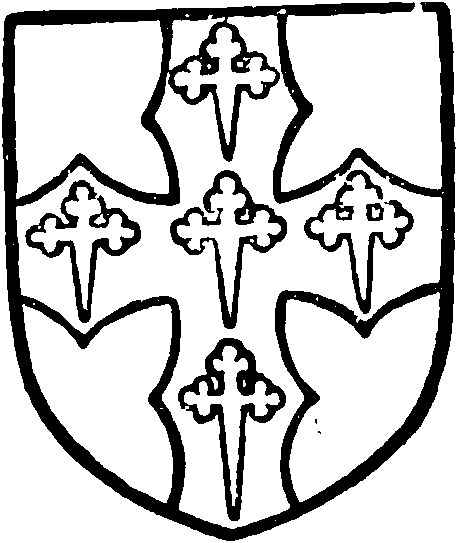
Waltham Abbey. Argent a cross engrailed sable with five crosslets fitchy or thereon.
The liberty was held by the monks until the Dissolution. (fn. 21) Henry VIII granted it to Thomas Knighton, (fn. 22) with the advowson of All Saints' Church, and it descended with All Saints (fn. 23) (q.v.) to Sir William Soame, who conveyed it to Edward Clarke in 1682. (fn. 24) Clarke's son Thomas held the manor in 1728 (fn. 25) and 1730. (fn. 26) On his death in 1754 he is said to have left the manor to Mrs. Jane Morgan, his niece, whose youngest son John died in 1792 and left half to his sister Jane and the other half to the representatives of his aunt Anne Freke. From Jane's son, Sir Charles Morgan, the one moiety passed finally to his grandchild Selina Rose Catherine wife of the Rev. W. T. Marsh Lushington-Tilson. (fn. 27) The other moiety came to Anne Freke's two granddaughters—Mary wife of the Rev. Edward Lewis and Fanny wife of the Rev. Francis Lewis. (fn. 28)
In 1881 the representatives of Mary and Fanny Lewis joined with Mrs. Lushington-Tilson in a sale of the whole manor to Messrs. Paine & Brettell of Chertsey. It was afterwards acquired from them by Mr. Hill of Nottingham, who sold it to Mr. George Pearson, father of Mr. Ernest Pearson, the present owner. (fn. 29)
Three virgates in Brickendon which had been held by three brothers before the Conquest were held by Baldwin, a serjeant of the king, at the time of the Domesday Survey. (fn. 30) This holding was probably identical with the I carucate in Brickendon which Miles de Somery (d. about 1229) (fn. 31) held by serjeanty at the king's storehouse (de dispensa). (fn. 32) Among the co-heirs of Adam grandson of Miles de Somery was John son of Ela Monchensey. (fn. 33) It is therefore possible that it was over the holding of Miles de Somery that Richard Monchensey had a grant of free warren in 1333. (fn. 34)
Another holding of 1086 consisted of 5 virgates which a certain Isenbard held of Geoffrey de Bech as a manor. It had been held by Leveron, a man of Archbishop Stigand's. (fn. 35) This is probably identical with the quarter of a knight's fee in Brickendon held of Alice Countess of Kent at her death in March 1415–16. (fn. 36) The Earls of Kent had evidently inherited their rights from Margaret sister and heir of Thomas second Lord Wake, who was descended from Emma daughter of Baldwin son of Gilbert de Clare. (fn. 37) The latter had succeeded Geoffrey de Bech in Eastwick (q.v.). The overlordship descended with the manor of Ware to Edward Earl of Warwick. (fn. 38) After his execution in November 1499 his interest in the manor was assigned to Margaret Countess of Richmond, grandmother of Henry VIII, (fn. 39) and on her death it lapsed to the Crown. (fn. 40)
Of the actual tenants of this holding little is known. About 1282 the tenant was possibly one of the name of 'Bellere.' (fn. 41) A 'manor of Brickendon' was held in January 1250–1 by Philip Darcy, who had a grant of free warren within it at that date. (fn. 42)
The third holding in the Domesday Survey was 1 virgate which Walter held of Geoffrey de Mandeville. (fn. 43) It had previously been held by Oswi, one of the men of Asgar the Staller. It is possible that this is a part of the knight's fee in Amwell (and Brickendon) subsequently held by the Abbot of Westminster of Hugh de Oddingselles. (fn. 44) This fee was probably attached to the manor of the abbey at Great Amwell, which included lands in Brickendon. (fn. 45) The monks of Westminster produced Saxon charters purporting to be the gift of Brickendon to the abbey by a certain Aelfhelm Polga and the confirmation of the same by Bishop Dunstan and King Edgar, (fn. 46) but the latter is certainly, and the former probably, a forgery. (fn. 47)
The Grange estate originated in copyhold and freehold land of the manor of Brickendon Bury, purchased by Benjamin Cherry of Hertford, gent., and by him bequeathed to his brother John Cherry. The mansion now known as the Grange was built by Benjamin son of John Cherry about the middle of the last century. The property has recently been sold by Mr. B. L. Cherry, grandson of Benjamin Cherry, to Mr. John Trotter, who resides at the Grange. (fn. 48)
Jenningsbury
The manor of JENNINGSBURY (Juveneles or Juvenelisbury, xiv cent.; Jenaldesbury 'la Mote' or Jovenellesbury, xv cent.; Genyngisbury, xvi cent.) was held as one knight's fee by Aymer de Valence Earl of Pembroke in 1303. (fn. 49) The manor was always held in chief, but the service is recorded as that of a quarter of a fee in the 15th century. (fn. 50) The family of Juvenal was connected with this neighbourhood about the year 1228, when William Juvenal, as guardian of the heir of Alexander Alders (de Alno), had the custody of the half of 2 carucates in Brickendon and Hoddesdon. (fn. 51) Aymer de Valence died in 1324, (fn. 52) and this manor was committed to the custody of Hugh le Despenser the younger (fn. 53) during the minority of Lawrence de Hastings (afterwards Earl of Pembroke), who was Valence's grand-nephew and one of his co-heirs. (fn. 54) In February 1326–7, shortly after the forfeiture of Despenser's land, the king assigned Jenningsbury to Juliane widow of John de Hastings, the father of Lawrence, in dower. (fn. 55) She had married Sir Thomas Blount, kt., (fn. 56) and afterwards became the wife of William de Clinton Earl of Huntingdon. (fn. 57) In 1345 Lawrence Earl of Pembroke, Juliane's son and heir, released to her third husband and his heirs all right in the manor of Jenningsbury. (fn. 58) It thus descended to the Earl of Huntingdon's nephew John Lord Clinton after the death of Juliane in 1367. (fn. 59)
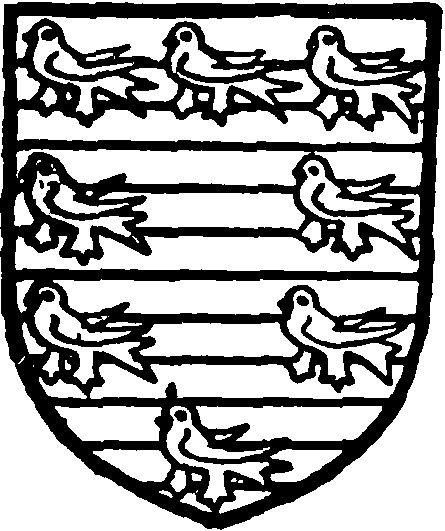
Valence. Burelly argent and azure an orle of martlets gules.
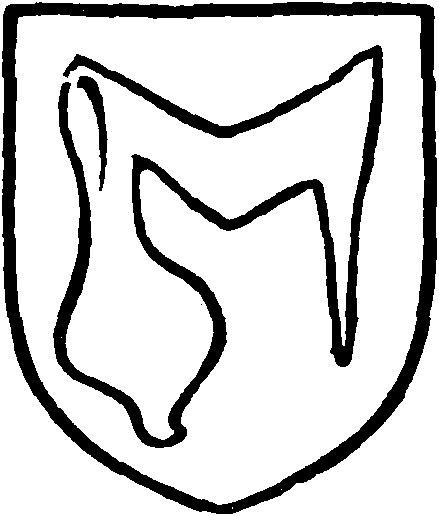
Hastings. Or a sleeve gules.
In 1391 the manor was in dispute between Reginald de Grey, grandson of Elizabeth, aunt of Lawrence Earl of Pembroke, who had died without issue, and Richard Talbot and others, representatives of the second sister of Lawrence's great-uncle, Aymer de Valence. (fn. 60) In accordance, however, with the settlement of 1345 Jenningsbury remained in the Clinton family until William Lord Clinton, grandson of John Lord Clinton mentioned above, enfeoffed Simon Stratford and others. (fn. 61) The feoffees transferred the manor to Richard Clitherow and John Chamberleyn, chaplain. (fn. 62) The tenant in 1402 was returned as John Clitherow, (fn. 63) and Richard Clitherow of Kent, esq., conveyed to Richard Claidich and others on 3 April 1415, evidently in trust for his son and heir Richard, upon whom the feoffees settled the manor in 1443. (fn. 64) William Lord Clinton was returned as tenant in 1428, (fn. 65) and, as in the case of Pirton (q.v.), his son and successor John apparently attempted to oust Roger son of Richard Clitherow from Jenningsbury. (fn. 66) Roger died on 12 March 1455, and the manor apparently passed to his daughter Eleanor wife of John Norres (fn. 67) of Goldstone, co. Kent. (fn. 68) A John Norres, apparently the younger brother of William Norres, who succeeded John in Goldstone, (fn. 69) held Jenningsbury jointly with his wife Isabel. He died on 12 October 1485, and his widow married Henry Marney. (fn. 70) Edmund Norres, son and heir of John and Isabel, probably sold the manor to Edward Sulyard, (fn. 71) who bequeathed it to his wife Anne and their heirs. (fn. 72) He died on 30 March 1516, leaving a son and heir William. (fn. 73)
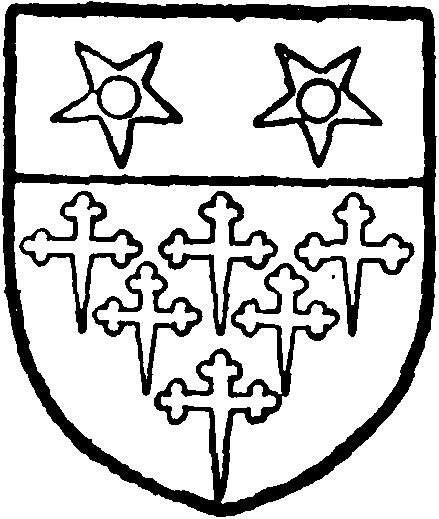
Clinton. Argent six crosslets fitchy sable and a chief azure with two pierced molets or therein.
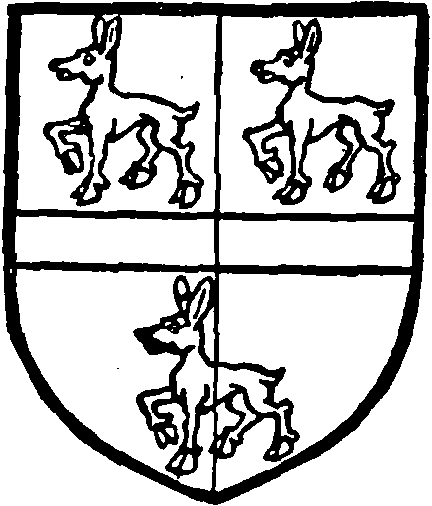
Gardiner of Jenningsbury. Party gules and or a fesse between three hinds tripping counter coloured.
The manor passed by sale to the family of Gardiner. Henry son of Henry Gardiner of London and Mary his wife were dealing with it in 1552. (fn. 74) Their son John was styled 'of Jenningsbury,' (fn. 75) and the manor descended to his son Henry Gardiner of Jenningsbury, (fn. 76) whose daughter and ultimate heir married Henry Dunster. (fn. 77) 'Henry Dunster of Jenningsbury, esq., was indicted for not repairing a footbridge on a footway from Hertford to Ware in 1671, (fn. 78) and in 1683 refused to pay his quota of the rate for building a house of correction. (fn. 79) His wife survived him. (fn. 80) Upon her death in 1718 her estates descended to her son Giles. (fn. 81) He died childless in 1724, and was succeeded by his nephew Henry Dunster. (fn. 82) Upon the death of the latter without issue in 1754 the estate of Little Amwell with Jenningsbury passed to his nephew Henry Dunster, who died on 23 August 1791. (fn. 83) In accordance with Henry Dunster's will the manor was sold to George Townshend Earl of Leicester, from whom it was purchased by Lord John Townshend (fn. 84) of Balls Park, great-grandfather of the sixth Marquess Townshend, who is the present owner. (fn. 85)
Little Amwell
The manor of LITTLE AMWELL, sometimes known as LITTLE AMWELLNBURY or RUSHEN, (fn. 86) was among the possessions of the abbey of Waltham Holy Cross at its dissolution on 23 March 1540. (fn. 87) It was distinct from the neighbouring manor of Brickendon, which with its members had been held by the canons since the foundation of their house. (fn. 88) It probably had its nucleus in the lands given to Waltham by Gilbert Monk ('Monacus') in the latter part of the 12th century. (fn. 89) These were the tenements of Henry the Salter ('Salinarius'), Siward Claud and Edward Felleden in Amwell near Brickendon and certain meadow lying in Broadmead, Caldwell and 'Hoco' (? Hook). (fn. 90) Gilbert's brother John confirmed this grant, (fn. 91) and Richard I included the land 'at Brickendon' (sic) given by Gilbert the Monk in his confirmatory charter to the abbey on 14 March 1189–90. (fn. 92) The land in the hamlet of Rushen came to the abbey by grant of Walter de Wyteberuwe (Widbury) and his wife Beatrice. (fn. 93) Other land in Amwell was held by the abbey of the fee of Philip son of Galien of Hertford, (fn. 94) who held of the Prioress of Cheshunt land acquired from Galien son of Joseph. (fn. 95) Philip and his wife Beatrice gave to the abbey Chadwell (Chaldewell) Grove and 'Chadwell holme' with a part of his meadow which was of the fee of Berkhampstead, desiring that the monks would improve the water supply from Chadwell Spring. (fn. 96) The abbey also acquired other small tenements in Amwell from various donors. (fn. 97)
The 'manor' of Little Amwellbury was let for forty years to Nicholas Norres in 1536. (fn. 98) After the surrender of Waltham Abbey on 23 March 1540 this manor was purchased from the Crown on 17 June 1542 by Richard Andrews of Hailes, co. Glouc., and Leonard Chamberlain of Woodstock. (fn. 99) They immediately obtained licence to convey to John Knighton of Aldbury the elder and to his son John Knighton the younger. (fn. 100) In 1576 John Knighton the elder of Bayford conveyed the manor to John son of George Knighton. (fn. 101) In 1590 George Knighton and his son John Knighton the younger had licence to alienate a moiety of the manor to John Knighton the elder, gent. (fn. 102) This last was evidently the son of Sir George Knighton of Bayford. He held a court for Little Amwell in 1614 (fn. 103) and was the last of his name. (fn. 104) He is said to have given the manor to Henry Gardiner of Jenningsbury, a gentleman 'knowing and ingenious in the management of the affairs of this country,' who had married his niece Mary Spring. (fn. 105) Little Amwell was thus united to the neighbouring manor of Jenningsbury, with which it has descended to the present Marquess Townshend.
The Abbot of Waltham obtained a grant of free warren in Amwell and elsewhere on 30 March 1253. (fn. 106) He had extensive liberties, including sac and soc, infangtheof and utfangtheof, and quittance from shires and hundreds throughout all his lands. (fn. 107) Thus the abbey had its 'liberty' of Little Amwell distinct from its 'liberty' of Brickendon; but it appears that Rushen was a tithing of Brickendon, (fn. 108) and it was to Brickendon that Gilbert the Monk and his heirs sent for the rent due for the lands with which he had endowed the abbey. (fn. 109)
The manor of Hertford Priory was styled in 1637 'the manor of Hertford Priors otherwise called the manor of the Priory of Hertford and now or late called or known by the name of the manor of Amwell or called and known by the name of the fee of Amwell.' (fn. 110) This was probably due to the close connexion between the Limesy fee in Hertford and Amwell. (fn. 111) The founder of Hertford Priory, Ralph de Limesy the elder (vetus), also endowed it among other holdings with a free tenement in Amwell, (fn. 112) evidently part of the fee which he held in 1086. (fn. 113) The priory had charters concerning this land from Ralph's uncle and from John de Limesy. (fn. 114). In the time of Richard I Ralph de Limesy, possibly the grandson of Geoffrey de Limesy and tenant of Great Amwell under the elder branch of the family, (fn. 115) attempted to exact from the priory aid towards scutage contrary to the effect of these charters. (fn. 116) The lands and rents of the priory in Amwell were valued at £1 0s. 2d. in 1291. (fn. 117) They may perhaps be identical with the estate held by the priory now known as BALLS PARK, which is a detached portion of the parish of Little Amwell, (fn. 118) surrounded by the parishes of St. John Rural and Brickendon Urban and Rural. (fn. 119) The name 'Balls' also exists in 'Balleshoke,' a meadow adjoining the footway from Hertford to Ware, near a former footbridge called 'High Bridge.' (fn. 120) Balleshoke was among the possessions of Hertford Priory in 1462. In that year Prior Thomas Walden failed to credit himself with various sums received to the use of the priory. These included 6s. 8d. paid by Thomas Blak and John Sadiller for hay crops at Balleshoke. (fn. 121) The capital messuage called 'Balles' was evidently included in those 'members' of the manor of Hertford Priory which lay in Amwell. It was held with the manor by Richard Willis at his death 16 October 1625, (fn. 122) and descended from him to Thomas Willis of Fen Ditton. (fn. 123) He sold with the priory manor to John Harrison of London in 1637 the mansion-house and farm called Balls 'and two other little tenements thereto belonging and now decayed.' (fn. 124)
Harrison rebuilt the house at Balls Park, where he was visited in 1643 by John Evelyn the diarist. (fn. 125)
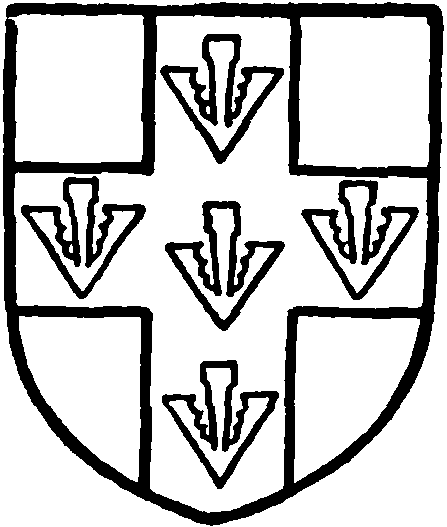
Harrison. Or a cross azure with five pheons or thereon.
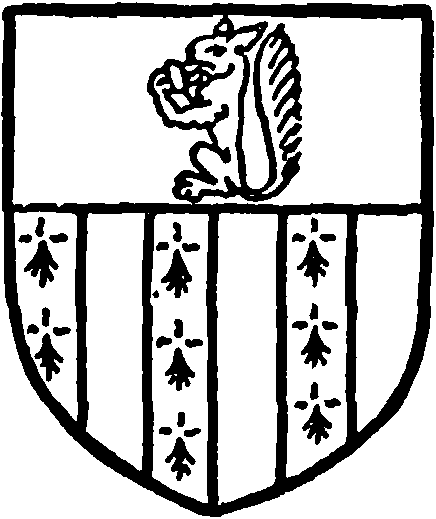
Faudel-Phillips, baronet. Paly ermine and azure a chief gules with a squirrel or therein.
He was one of the farmers of the customs (fn. 126) in 1640–1 and M.P. for Lancaster. (fn. 127) Charles I knighted him in 1640 in reward for advancing £50,000 on the security of the subsidies; but it was with difficulty that he overcame the scruples of the Long Parliament regarding the payment of interest. (fn. 128) He supported the Royalist cause until August 1645, when he tried to surrender to Parliament. (fn. 129) His estates had been sequestrated, Balls Park was in the hands of a certain Mr. Rolles, who left it empty, making scarcely any use of the orchard and gardens, and Lady Harrison and her children were homeless. (fn. 130) Harrison fled to France and only recovered his estates in 1648 by paying a fine of £1000. (fn. 131) After his death in 1669 Lady Mary retained Balls Park for life. She died in 1705. (fn. 132) The estate was inherited by her son Richard, (fn. 133) and ultimately passed to his third son Edward Harrison, who had served the East India Company as Governor of Fort St. George in 1711 and was appointed postmaster-general in 1726. (fn. 134) His daughter and heir Audrey wife of Charles third Viscount Townshend was the brilliant and witty friend of Horace Walpole (fn. 135) and the mother of Charles Townshend, chancellor of the Exchequer, (fn. 136) who doubtless inherited from her his eloquence and facility of repartee. Her uncle George Harrison lived at Balls until his death in 1759. (fn. 137) She died 5 March 1788, having bequeathed the estate to her grandson Lord John Townshend. (fn. 138) It descended to his son John, who became Marquess Townshend in 1855 upon the death of his cousin George, the third marquess. (fn. 139) Balls Park was one of the principal seats of his son, the fifth marquess. (fn. 140) The present owner is Sir George Faudel Faudel-Phillips, bart., who purchased the estate (where he had already resided for some time) in 1901.
The house is an early and interesting example of the purer type of design which the influence of the work of Inigo Jones was beginning to make fashionable towards the end of the first half of the 17th century. Built, so far as can be ascertained, soon after the year 1640 (see above), the elevations have so completely lost the characteristics of the preceding Jacobean style as to appear at a little distance contemporary with the large sash-windows by which the original casement frames were replaced early in the 18th century, when the house was enlarged by the addition of a kitchen wing on the west. The original house, which is square on plan with a central court, perhaps originally open, but now covered in, is of two stories elevated on a basement, with an attic floor in the roof, and is built of narrow red bricks, the courses varying in depth from 2¼ in. to 2½ in., with occasional dressings of stone. All four elevations are of equal length and height, and are crowned by uniform slated roofs, hipped at the angles, and having projecting eaves supported by large and widely-spaced console brackets of wood. An elaborate string-course of moulded brick, which marks the level of the first floor, runs round the whole building, and the architraves of the windows are also of moulded brick, while the angles are emphasized by rusticated quoins of the same material. The walls set back from the face of the basement with a bold inverted cyma. The entrance doorway in the centre of the principal or north front has elaborate dressings of stone, from which the paint has recently been removed. It has a semicircular head and is flanked by Tuscan pilasters, from which spring bold consoles of considerable projection supporting a balcony above. Their design and that of the ornament above the keystone of the doorway betray their early 17th-century origin. The firstfloor window over the doorway has also a semicircular head with a continuously moulded architrave, and is flanked by Ionic pilasters, each with a swag depending between the volutes. In the tympanum of the pediment which crowns the design is the shield of Harrison, with the crest of a cuffed arm holding in the hand a broken dart. The centres of the elevations on either side of the doorway are accentuated by semicircular heads to the first-floor windows, which with those of the ground floor are elsewhere square-headed. The basement is lighted by semicircular-headed openings with rusticated dressings of moulded brick. The south front has a central doorway with a porch supported by fluted Ionic columns. This feature is clearly shown to be an addition of the Queen Anne period as well by its greater purity of design as by the method in which the moulded brick string-course at the first floor level is rudely cut away for its insertion—a strong contrast to the workmanlike way in which it is stopped in stone for the dressing of the entrance doorway on the north front. Above is a semicircular-headed window flanked by sham 'œils-de-bœuf.' The east and west elevations are of similar type, with the exception that each stage has pilasters at the angles. The later additions on the west partly conceal this elevation.
The entrance doorway leads by a short passage directly into the central court, known as the vestibule, which has recently been panelled with oak in the Jacobean style, replacing a painted scheme of wall decoration dating from the Queen Anne reconstruction of the house. The fireplace here, which is of Jacobean date, was brought from elsewhere. To the east of the entrance, occupying the remainder of the south front on this side, is the dining room, the walls of which are lined with painted panelling. The original kitchen probably occupied the corresponding portion of this front to the west of the entrance. The offices are now principally contained in a building added to this side of the house at the 18th-century reconstruction. South of the dining room and separated from it by the main staircase hall is the oak parlour, the ceiling of which appears to be of the original date. Opposite the main entrance, leading out of the hall or vestibule, is a short passage connecting with the south or garden entrance. Some 17th-century panelling is preserved here. Over the fireplace of the small room to the east of the garden entrance is a view of the house, painted, to judge from the figures introduced into the foreground, about the middle of the 17th century. The lay-out of the surrounding gardens has completely disappeared, but in other respects the house presents much the same appearance as now, with the exception that casement frames take the place of the sashes inserted later. The remaining rooms on the ground floor contain little of architectural interest. A later staircase has been formed on the west side of the court. The satin drawing room, over the entrance on the north, and the long gallery on the east, over the dining room and oak parlour, are more nearly in their original condition than any of the principal rooms on the ground floor. Their panelling is divided into compartments by fluted Corinthian pilasters, having the lower third of their shafts enriched with arabesque designs. The panelling of the long gallery is now painted, and, with the exception of the pilasters, is probably 18th-century work. The ceiling of the drawing room, with its wreaths of fruit and flowers in comparatively shallow relief, appears to be of original date with the house. In the principal bed room on the south side of the house is a fine marble chimney-piece of the late 18th century, which was formerly in the vestibule. The corridor communicating with the apartments here has an original plaster ceiling on which is the Harrison crest. Generally the interior has been much modernized, but sufficient detail remains to show that the building is substantially that which was erected by Sir John Harrison about the year 1640.
CHURCH
The church of HOLY TRINITY, Little Amwell, was built and endowed about the year 1863. It is in 13th-century style, and consists of chancel, nave, transept, north porch and eastern spire. The advowson is vested in trustees. (fn. 141)
The history of the parish church of All Saints and the charities for that parish are given under the borough.
